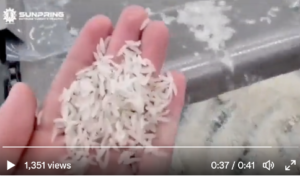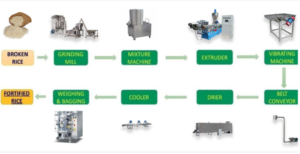We noticed this video circulating on social media along with claims that it depicts “fake” plastic rice being produced in a factory. Some responses claim it is a plot to increase profits, while others theorise is it part of a wider food-based conspiracy alongside products such as GMO foods and insect-based protein. The video shows white strips being fed into a machine and emerging as rice-like grains. The video does not show the grains being mixed or used, nor does it specify where it was taken. As the video does not include audio, there is also no specific mention of plastic at all.
The video shows white strips being fed into a machine and emerging as rice-like grains. The video does not show the grains being mixed or used, nor does it specify where it was taken. As the video does not include audio, there is also no specific mention of plastic at all.
After enhancing screenshots of the low-resolution clip to identify text on the top lefthand corner that reads “SUNPRING, extrude yummy & healthy,” a quick google search led us to the SunPring website. SunPring is a Chinese company that sells specialized extrusion machinery and equipment. Among the different extrusion machines displayed on their website is a rice extruder identical to the machine used in the circulating video. We also found the original video in much better quality on the SunPring Extrusion Youtube channel, titled “Artificial rice extruder nutritional rice making machine FRK fortified rice machine.
We also found the original video in much better quality on the SunPring Extrusion Youtube channel, titled “Artificial rice extruder nutritional rice making machine FRK fortified rice machine.
 In the comment section, SunPring answers in the affirmative to a comment about “broken rice” being used to produce the artificial rice. Based on our research, artificial rice is also sometimes referred to as fortified rice. It is typically made of broken rice and other nutrient additives such as Vitamin A and Iron, producing a nutrient content higher than that of regular rice.
In the comment section, SunPring answers in the affirmative to a comment about “broken rice” being used to produce the artificial rice. Based on our research, artificial rice is also sometimes referred to as fortified rice. It is typically made of broken rice and other nutrient additives such as Vitamin A and Iron, producing a nutrient content higher than that of regular rice.
Broken rice refers to rice grains which have been broken during harvesting and processing but have not lost any nutritional value. To make artificial or fortified rice, broken rice is ground into rice flour, mixed with water and nutrients, and processed by an extruder into kernels that are visually comparable to unbroken rice grains.

Artificial rice is typically mixed with regular rice in small amounts to boost its nutritional value without compromising food habits and taste. It also serves to repurpose broken rice. Furthermore, as artificial rice costs more to produce than regular rice, it is unlikely to be a way of undercutting consumers or boosting profits for manufacturers. SunPring also goes into detail about rice extrusion technology and applications, pointing out that it is used worldwide, particularly in food-scarce regions where poor nutrition is an issue.
While some social media responses to the claim video have expressed a distrust of China and Chinese factories, artificial rice has been an established product for several decades. One version of artificial rice, Ultra Rice, was developed in the United States, while the extrusion method shown in the video was developed in China under the brand NutriRice, which has been 50% owned by Swiss technology group, Bühler, since 2013. Both use broken rice as their base ingredient and this rice-based component is being misrepresented as plastic in the circulating video.
In summary, while the product being made in the video is, indeed, artificial rice, it is not made from plastic. Rather, it is made from broken rice through an established production technique with technology that has been utilized worldwide. Further, the video depicts a demonstration by an extrusion machine manufacturer rather than artificial rice being mass produced. We therefore give the video and associated claims about “plastic rice” a rating of false.

Reports of plastic rice from China have been debunked several times over the past decade, with articles from 2015, 2016 and 2017 demonstrating the recurrence of such claims. While all have been proven false, misleading videos such as this one build on existing fears over food supply and adulteration and can spread widely on social media, further entrenching those fears.
This misinformation might prove particularly harmful as fortified rice becomes more common. Countries such as Costa Rica and India have taken steps to push fortified rice as a public health initiative, and resistance to rice perceived as artificial or “made of plastic” would hamper those efforts.



